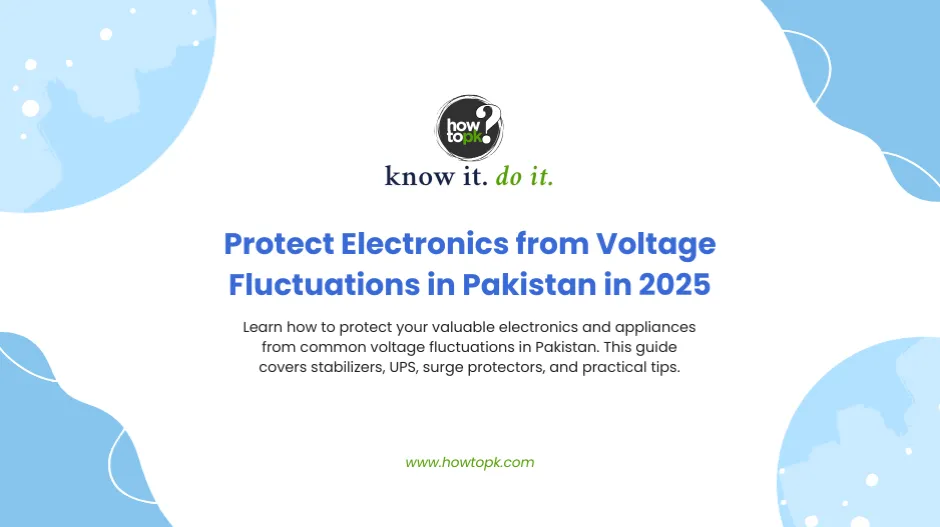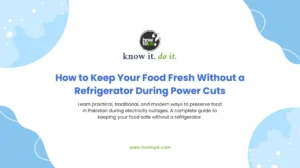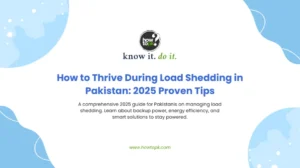Living in Pakistan often means dealing with inconsistent electricity supply. Voltage fluctuations, whether they are sudden drops (brownouts), sharp increases (surges), or sustained high or low voltage, can be a real headache. More importantly, they can cause serious damage to your expensive electronics and appliances, shortening their lifespan or even rendering them useless.
This guide is designed to be your complete resource, walking you through practical steps and solutions tailored for the Pakistani environment. We’ll cover everything from simple habits to investing in crucial protective equipment, ensuring your devices stay safe and sound.
Understanding Voltage Fluctuations and Their Impact
Before we dive into solutions, let’s understand what we’re up against.
What are Voltage Fluctuations?
In simple terms, voltage is the “pressure” of electricity flowing through your wires. In Pakistan, the standard household voltage is 220-230 volts. When this voltage deviates significantly from the standard, it’s called a voltage fluctuation.
| Type of Fluctuation | Description | Signs / Causes | Potential Risks |
|---|---|---|---|
| Brownouts (Under-voltage) | Voltage drops significantly below the normal level. | Lights dim, appliances run sluggishly. | Strains motors and damages sensitive electronics if prolonged. |
| Over-voltage / Voltage Spikes | Voltage momentarily or continuously rises above the normal range. | Lightning strikes, grid issues, sudden transformer load changes. | Can damage electronics and shorten appliance lifespan. |
| Power Surges | Extremely brief but very high spikes in voltage, often thousands of volts. | Common after lightning strikes or power restoration. | Instantly fries circuits and destroys devices. |
Why Are They Dangerous for Your Electronics?
Your electronic devices are designed to operate within a specific voltage range. When the voltage goes outside this range, it can have several damaging effects:
| Effect of Voltage Fluctuation | Explanation | Devices Most Affected |
|---|---|---|
| Overheating | Low voltage makes devices draw more current, while high voltage directly overloads components, both leading to heat buildup. | All electronics, especially high-power devices. |
| Component Damage | Sensitive parts like capacitors, resistors, and ICs can be permanently damaged or degrade over time. | Computers, TVs, chargers, networking equipment. |
| Motor Burnout | Motors run inefficiently and overheat under voltage fluctuations, leading to burnout. | Refrigerators, ACs, washing machines, pumps. |
| Data Loss | Sudden power cuts or extreme voltage events can corrupt or erase data. | Computers, servers, storage devices. |
| Reduced Lifespan | Continuous exposure to unstable voltage wears out devices faster. | All electronics and appliances. |
Step 1: Simple Habits and Awareness
Before investing in any equipment, some basic practices can go a long way in protecting your electronics.
What to Do: Disconnect During Power Outages and Fluctuations
When the electricity goes out, or you notice severe flickering or dimming of lights, immediately unplug your sensitive electronics.
| Step | Details |
|---|---|
| Why to Do It | When power returns after an outage, it often comes back with a surge or unstable voltage. This “power-back surge” can damage electronics. Disconnecting during severe fluctuations removes devices from the unstable supply. |
| How to Do It | Unplug devices like TVs, computers, gaming consoles, and even refrigerator/AC plugs when power goes off or when you detect significant voltage instability. This is a free and effective first line of defense. |
| Common Mistakes / Tips | Don’t just turn devices off, pull the plug from the wall. Be especially cautious during thunderstorms or if you hear unusual noises from your local transformer. |
What to Do: Understand Your Home’s Wiring and Earthing
A good earthing (grounding) system is fundamental to electrical safety and protection.
| Step | Details |
|---|---|
| Why to Do It | Earthing provides a safe path for excess electricity (from surges or faults) to dissipate into the ground, preventing damage to appliances and reducing the risk of electric shock. |
| How to Do It | Have a qualified electrician inspect your wiring and earthing system, especially in older homes. They should verify the presence of a dedicated earth wire, proper connection to an earth rod, and that resistance is within safe limits. |
| Common Mistakes / Tips | Many older homes in Pakistan have poor or no earthing. Never assume it’s safe, get a professional inspection if you face frequent electrical problems. |
What to Do: Group Electronics Wisely
Avoid plugging all your high-power appliances into a single extension board.
| Step | Details |
|---|---|
| Why to Do It | Overloading a single circuit or extension board can cause overheating and voltage drops, which stress and damage devices. |
| How to Do It | Spread appliances across multiple wall sockets or circuits. Avoid plugging high-power devices (e.g., refrigerator, washing machine, iron) into the same outlet using a multi-plug adapter. |
| Common Mistakes / Tips | Always check the total wattage or amperage of devices connected to one point. If an extension board feels warm, it’s a sign of overloading. |
Step 2: Essential Protective Devices
Now, let’s talk about the specific devices that actively protect your electronics.
What to Do: Install Voltage Stabilizers
A voltage stabilizer is perhaps your most important piece of equipment against ongoing voltage fluctuations.
| Step | Details |
|---|---|
| Why to Do It | A voltage stabilizer regulates incoming voltage to a safe, consistent level (around 220–230V), protecting appliances from both high and low voltage issues common in Pakistan. |
| How to Do It | Relay-Type Stabilizers: Most common and affordable; use relays to switch transformer taps; ideal for TVs, refrigerators, small ACs; make a clicking sound when switching. Servo-Controlled Stabilizers: More precise and faster; use a servo motor for smooth voltage adjustment; great for sensitive/expensive electronics; quieter but costlier. Digital/Static Stabilizers: Solid-state, fast, and highly precise; no moving parts; ideal for critical IT or sensitive equipment; most expensive option. |
| Common Mistakes / Tips | Choose the right stabilizer type for the appliance. Avoid undersized stabilizers (check the appliance’s power rating). Place stabilizers in a ventilated area to prevent overheating. |
Selection Tips:
| Factor | Details |
|---|---|
| Capacity (kVA/Amps) | Select a stabilizer with the correct capacity for your appliances. Check the wattage (W) or amperage (A) of each device, sum them, and choose a stabilizer with a slightly higher kVA rating. Example: A 1-ton AC may require 2–3 kVA; a whole-house stabilizer may range from 5–15 kVA or more depending on total load. |
| Input Voltage Range | Choose a stabilizer that can handle your area’s typical fluctuations. For very low (e.g., 140V) or very high (e.g., 280V) voltage areas, ensure the stabilizer’s input range covers these extremes. |
| Time Delay Function | Essential for compressor-based appliances (refrigerators, ACs). Delays restart after power cuts, allowing compressor pressure to stabilize, preventing damage. |
| Brand & Warranty | Opt for reputable brands in Pakistan with good after-sales service and warranty coverage. |
| Common Mistakes / Tips |
|
What to Do: Use Uninterruptible Power Supplies (UPS)
A UPS is more than just voltage protection; it’s also a battery backup.
| Aspect | Details |
|---|---|
| Why to Do It | A UPS provides temporary battery power during outages, giving time to safely shut down sensitive electronics and avoid data loss or hardware damage. Many models include Automatic Voltage Regulation (AVR) to stabilize voltage. |
| Types of UPS | Standby / Offline: Basic home use; switches to battery only when power fails, slight switchover delay, cost-effective. Line-Interactive: Monitors voltage continuously, has AVR without switching to battery, faster switchover. Online / Double Conversion: Always runs devices on clean battery power, zero transfer time, best protection, high cost, used for critical applications. |
| Capacity (VA/Watts) | Choose capacity based on total device wattage. Typical ranges: Home UPS (lights/fans): 600–1000 VA; Computer setups: 800–1500 VA. |
| Battery Type & Backup Time |
|
| Common Mistakes / Tips |
|
What to Do: Integrate Surge Protectors
A surge protector is a simple but vital device for catching sudden, very high voltage spikes.
| Aspect | Details |
|---|---|
| Why to Do It | Surge protectors defend against massive, momentary voltage spikes (e.g., lightning strikes, grid switching) by absorbing/diverting excess energy away from electronics. Acts like a firewall against extreme voltage events. |
| How to Do It | Available as single-outlet wall units or multi-outlet strips. |
| Key Specs |
|
| Points of Protection | Individual Surge Strips: Protect single workstations or entertainment setups. Whole-Home Surge Protectors: Installed at main panel, protect all home circuits, requires professional installation. |
| Common Mistakes / Tips |
|
What to Do: Consider Digital Voltage Protector Breakers
These devices offer a quick cut-off mechanism for dangerous voltage levels.
| Aspect | Details |
|---|---|
| Why to Do It | A digital voltage protector breaker works as an automatic switch that cuts off power instantly if voltage goes beyond preset high/low limits. Prevents immediate appliance damage. Restores power automatically after voltage stabilizes, with a short delay. |
| How to Do It |
|
| Common Mistakes / Tips |
|
Step 3: Advanced Considerations and Maintenance
For comprehensive protection and longevity, there are a few more things to keep in mind.
What to Do: Regular Electrical Inspections
Periodically, have a qualified electrician inspect your home’s electrical system.
| Aspect | Details |
|---|---|
| Why to Do It | Worn-out wiring, loose connections, or an inadequate main circuit breaker can cause voltage problems and increase the risk of damage. Regular inspections catch issues before they become critical. |
| How to Do It |
|
| Common Mistakes / Tips |
|
What to Do: Maintain Your Protective Devices
Protective devices also need care to function optimally.
| Aspect | Details |
|---|---|
| Why to Do It | Stabilizers, UPS batteries, and surge protectors degrade over time. Maintenance ensures they remain effective and reliable. |
| How to Do It | Stabilizers: Keep in a well-ventilated spot to avoid overheating. Clean dust from vents regularly. Servo stabilizers may require occasional lubrication or technician checks. UPS Batteries: For wet cell types, check and top up distilled water every 1–3 months. Keep terminals clean. Avoid frequent full discharges. Surge Protectors: Replace immediately if the “protection active” light goes out. |
| Common Mistakes / Tips | Ignoring signs like unusual stabilizer noises or fast-draining UPS batteries can lead to a false sense of security. Address issues promptly to prevent appliance damage. |
What to Do: Invest in Quality Electrical Accessories
From wiring to plugs, quality matters.
| Aspect | Details |
|---|---|
| Why to Do It | Cheap, substandard wiring and plugs can cause resistance, overheating, and localized voltage drops, compromising appliance safety. |
| How to Do It |
|
| Common Mistakes / Tips | Avoid cutting corners on electrical components. Short-term savings can lead to costly appliance damage or even fire hazards. |
Putting It All Together: A Layered Approach
The best way to protect your electronics from voltage fluctuations in Pakistan is to adopt a layered defense strategy. No single device provides complete protection against all types of power issues.
| Category | Details |
|---|---|
| Foundation – Good Earthing and Wiring | Ensure your home has a robust and properly installed earthing system. This is the most basic safety net. |
| First Line of Defense (Fluctuations) – Voltage Stabilizers | Essential for handling daily high and low voltage issues common in Pakistan. Install for sensitive appliances or your entire home. |
| Second Line of Defense (Surges) – Surge Protectors | Crucial for absorbing sudden, destructive spikes in voltage, including those caused by lightning. Use for your most valuable electronics. |
| Third Line of Defense (Outages & Data Loss) – UPS Systems | For computers and devices requiring uninterrupted operation, a UPS provides battery backup and voltage regulation for graceful shutdowns. |
| Behavioral Defense – Disconnect and Maintain | Unplug devices during severe fluctuations or outages, and regularly maintain all protective equipment. |
By combining these strategies, you can significantly reduce the risk of damage to your valuable electronics and ensure their long, reliable operation, even in Pakistan’s sometimes challenging power environment. It’s an investment that truly pays off in peace of mind and savings on repair or replacement costs.
Resources
- Electrical Retailers – Look for reputable electronics and electrical appliance stores in your city. Many large electronics chains and authorized dealers carry a range of voltage stabilizers, UPS systems, and surge protectors.
- Local Electricians – For wiring inspections, earthing improvements, and whole-home stabilizer installations, consult certified and experienced local electricians.
- UPS and Battery Brands (Common in Pakistan):
Homage
Inverex
Crown
Osaka
AGS
Daewoo
Phoenix - Stabilizer Brands (Common in Pakistan):
Stabimatic
Max Power
Crown
Powerage - Surge Protector Brands – Many international and local brands are available. Look for products with clear joule ratings and safety certifications.







